- Home
- Allison Brennan
Playing Dead pb-3 Page 3
Playing Dead pb-3 Read online
Page 3
“This is my house,” Tom said. “There’re two dead bodies in the bedroom. I didn’t touch anything.” Not that it would matter, Tom thought. It was his house, his gun, his wife in bed with another man.
He knew what the crime scene looked like. He knew what these cops would think as soon as they saw the naked bodies.
Worse, he knew what Claire thought. How could he convince her he’d never hurt her mother?
Parks and another cop-Reynolds-went in and searched the house, came out, and said, “Detectives are on their way, and the chief of police.”
Tom nodded.
“What happened?” Reynolds asked quietly. “You came home for lunch and found your wife in bed with another man? Just lost it?”
“I didn’t kill anyone.”
“It’s just you and me, Tom.”
Tom turned. He wasn’t going to answer any questions. He knew better than to talk without an attorney.
Seventy-two hours later he was arrested on two counts of murder.
THREE
When Mitch Bianchi trained in underwater forensics, he thought he’d find something he was not only good at, but enjoyed.
He was very wrong, at least on the latter point. He was good at it-combining his love and skill of diving with his innate law enforcement savvy. But recovering floaters was the worst job in the Bureau, even worse than his work identifying remains in the mass graves in Kosovo early in his FBI career.
But skill trumped desire every time in the Bureau, and this time Mitch had a stake in the investigation. If Oliver Maddox was dead, it gave Mitch one more direction to turn in his private investigation into the murders of Lydia O’Brien and Chase Taverton.
“You’re quiet this morning,” Steve Donovan said as he turned onto River Road heading toward Isleton, where Maddox’s white Explorer had been found in the river. According to the sheriff’s diver, the victim in the driver’s seat had been there for a while. Four months? Possible. And it would confirm Mitch’s suspicion that Oliver Maddox had found out something that made someone nervous enough to kill. Again.
“Just thinking.”
“Funny how you never mentioned you were house-sitting for Nolan while he’s at Quantico.”
Mitch didn’t show a physical reaction. “How’d you hear?”
“Nolan called in last week for some of his files and mentioned it in passing. I remembered he lives only two blocks from Claire O’Brien. So I drove by a couple times, just to check it out, and surprise, I saw you sitting and talking with her at Starbucks Sunday morning. I didn’t have a chance to call you on it in private until now.”
Trying to come up with a lame excuse or lie would only damage Mitch’s friendship with Steve. “You knew I was looking into O’Brien’s case.”
“I didn’t think you were playing with O’Brien’s daughter.”
“It’s not like that, Donovan.”
“Don’t jerk me around, Bianchi. You’re playing a dangerous game here. Meg will draw and quarter you if she finds out you’re working the O’Brien case after you were removed. The only reason you’re on this assignment is because you’re the only diver we have in-house.”
“It’s complicated.” Mitch had to tell Steve the truth. In some ways, he was grateful that Steve had confronted him. Mitch could use a fresh mind to go over the details.
“We have a twenty-minute drive,” said Steve.
“We’ll talk later. I need to lay it out for you. I still don’t know enough to draw any solid conclusions.”
Steve’s mouth tightened. “Don’t screw with me anymore.”
“I won’t.”
“Seven o’clock, tonight, Fox amp; Goose, and you’re paying.”
“Fair enough.” Mitch didn’t want to meet at the Fox amp; Goose-he and Claire were supposed to go there tonight to listen to friends of hers who had a band-but Mitch wasn’t picking Claire up until eight. An hour with Steve, then he could drive the five minutes to Claire’s place. Steve would be long gone.
He planned to tell Steve all about his deception. Everything from his research into the O’Brien-Taverton murders to O’Brien saving Mitch’s life to Mitch befriending Claire under false pretenses. The truth about everything, except for how close he and Claire had become over the last couple months. Mitch couldn’t acknowledge to Steve-to anyone-that his feelings for Claire had moved far beyond professional interest.
They drove in awkward silence. Mitch looked through his notes on Oliver Maddox. He first learned of O’Brien’s connection with the law student through the prison visitor logs. Mitch had looked for Maddox after the prison break, ostensibly because O’Brien might have tried to contact him. But he’d been pulled from the O’Brien case almost immediately. Politics or jurisdictional grandstanding, he didn’t know which. He should have stopped then, but when Mitch found out that Maddox had been missing since a week before the earthquake, his instincts told him something was rotten. He put a BOLO on Maddox with his license plate and description.
Now they had Oliver Maddox’s car and a grossly decayed body at the wheel. After four months the victim would be impossible to positively identify at first glance. Hell, a floater after twenty-four hours was green and sloshy and hard to ID.
Mitch’s instincts told him it was Maddox. Disappeared without a trace, and now his car was found underwater.
Accident? Or murder?
The narrow, two-lane road to Isleton that followed the meandering Sacramento River was one of the most dangerous in the county. Accidents were common, especially during rain or the deadly fog that often descended upon the San Joaquin Valley. There was no guardrail to protect a motorist from going into the river. Once in the water, most accident victims didn’t survive.
The California Delta covered over 738,000 acres. Hundreds of miles of waterways cut through the Delta, the water coming from the Sierra Nevadas through not only the Sacramento River, but numerous smaller rivers and creeks. They all eventually converged before merging with the San Francisco Bay. Isleton was a small river town of fewer than a thousand residents in the southwest corner of Sacramento County. It was known for its annual summer Crawdad Festival and not much else. Mitch didn’t want to think about what those crawdads had done to the body in the Explorer.
Maddox’s vehicle had been found in the river two miles north of the city limits. The Sacramento River flowed steadily, but today’s current didn’t look too bad.
A crowd had gathered alongside the river: local cops and their FBI team. Steve pulled up next to the emergency vehicles and said, “Ready?”
“Always,” Mitch replied.
They got out and a deputy sheriff-Clarkston on the badge-approached with the sheriff’s diver. The local diver was older than Mitch and a foot shorter, graying, with a craggy face and unusually large hands. “Harry Young. Thanks for coming out.”
They shook hands, exchanged credentials, and Young said, “I didn’t disturb the car. It’s a white 1998 Ford Explorer, registered to Oliver Maddox. A missing person report was filed by Tammy Amunson on January 23 of this year. One victim in the driver’s seat, been under for a time-eyes gone, fingers missing. A lot of critter damage, but the trunk and limbs are intact. No visible wounds, seat belt intact and engaged, windows down or broken on impact.”
“Was there any evidence along the riverbank of a car going into the water?”
“If there was, it’s long gone. Four months, rain, weather, growth.”
“Who found it?”
“Fisherman. Early this morning, at dawn. His line got caught and when he freed it, he got a chunk of clothing with it.”
“Where’s the evidence now?”
“Bagged,” the deputy said. “It’ll go to our lab.”
The deputy was more antagonistic than the older, easygoing diver. Mitch smiled at him. Play nice with the locals, he could hear Meg’s stern lecture. The FBI had better relations with local law enforcement in recent years, but some cops were old school.
“How deep?” he asked.
> The diver responded. “Thirty feet. We got someone from the EPA on the way since this is an environmentally protected area.”
“It’s now a crime scene.”
Young grinned, patted Mitch on the back. “I’m gonna like you. I got the crew waiting to haul the car up, but your office said don’t touch the vehicle. Don’t much see what you can do down there.”
“We want as much evidence as possible intact before we haul up the vehicle. We may bag the body underwater and bring it up separately to minimize damage.” But if it was too difficult to remove the body from the vehicle, they’d bag what they could and haul up the body with the SUV. “What kind of fish activity do we have here?”
“Sturgeon, stripers, crawfish. Hell, this is a terrific fishing spot.”
“It was an accident,” the deputy interrupted.
Mitch raised his eyebrows. “You have a witness who saw it?”
“No, but-”
“Don’t assume anything.”
The deputy bristled at Mitch’s tone. Mitch kept his expression calm: Diplomacy wasn’t his strength. Action was.
Steve smoothed the tension, saying to Young, “Why don’t you dive with us? You can see what we do, maybe it’ll help in future investigations.”
“Doesn’t look like you need us,” Clarkston said.
Young interjected, “I’d like to go back under. Good practice.”
Mitch took Steve’s lead. “Great. I need an experienced partner.”
Steve pulled Young and Clarkston away from Mitch and showed them the sophisticated underwater camera the ERT unit had purchased last year with their limited discretionary budget.
Mitch walked over to Special Agents Duncan and Morales. Though both were young-about thirty, coming into the Bureau under the age of twenty-five, a rarity these days-he didn’t have to tell them what to look for.
“Split up and take a Sheriff’s deputy with you.” He pointed north and south of their location. “We’re looking for where the Explorer went in, but based on the remains it was months ago. Anything you find, mark it and inform Donovan. I’ll be underwater.”
When Mitch first joined the FBI more than a decade ago, the Violent Crimes Squad had been one of the best-staffed and funded units in the Bureau. They’d have had a full squad of eight out here to recover the body and evidence. After 9/11, resources for their unit were minimal and staffing was barely twenty percent of what it had been. Priorities had shifted to counterterrorism and counterintelligence. Mitch had mixed feelings about the changes, but he’d adjusted accordingly. They all had.
Mitch finished putting on his diving gear. Even though he was about to enter murky river water and face a dead man, a rush overcame him.
He met up with Young and they checked and double-checked the equipment, then went out on the boat over the spot where the Explorer rested beneath the surface. Steve and a deputy manned the boat while Young and Mitch fell back into the cold water.
Maddox had been missing since the end of January. Chances were he’d been in the river the entire time. But proving it was homicide instead of an accident would be difficult at best, unless they were lucky enough to find a bullet entry wound or obvious stab marks. The fish and crustaceans would feed on any exposed areas first, which often made it more difficult to determine how a body had been assaulted. But a gaping wound no matter how gnawed by river life would point toward foul play.
The water was icy, having traveled from the Sierra Nevadas where the snow had been melting all spring, filling the creeks and tributaries, merging to make this river. The ninety-degree weather did little to warm the thirty-foot depths where the Explorer rested, its wheels buried deep in the sediment. The wet suit protected Mitch from the worst of the cold, and he took a moment to acclimate himself to the water pressure, diminished light, and temperature.
He approached cautiously, taking the time to inspect and photograph the front of the vehicle-there were no obvious collision marks. They’d need a more detailed inspection, but it appeared that nothing had hit this SUV, front or back. There was some minimal damage on the passenger side, but nothing to indicate a collision so violent it could push a car into the river. One problem with water was that it carried evidence away from the scene. If there had been branches or leaves embedded in the undercarriage of the car, suggesting perhaps where the vic went in, the evidence could easily have been washed away under the constant pressure of the flowing river.
The Explorer was fully submerged and held fast, the front end sinking deeper into the muck because of the weight of the engine. The water wasn’t too murky at first, the sun above cutting through, though as they walked along the bottom of the river and disturbed the sludge, their field of vision deteriorated. The underwater lights he and Young used cast an odd illumination around them, making the shadows darker.
Only the windshield was intact, which suggested the driver hadn’t hit the water with any great speed. Mitch ran his finger along the window edge, felt the top of the retracted driver’s-side window. The smooth edge told him that it had been down when the vehicle went in. Mitch inspected the other windows. They’d all been down on impact; none had broken under the pressure. Who drove with all their windows down in the frigid cold of a Sacramento January? He indicated the evidence to Young, who did his own inspection and nodded.
The victim was strapped into the driver’s seat. Most victims would unbuckle themselves and attempt to escape, unless the accident rendered them unconscious.
It was virtually impossible to tell anything about the victim, though with the constant movement of the fresh, cold mountain water through the car, decomposition wasn’t as advanced as Mitch would have guessed. A recent body would have been dark green, but this body was extremely pale, almost translucent, as the gases in the body had leached out over time. The body was intact for the most part, though Mitch knew if they tried to move it, skin, hair, and potential evidence would be lost. The vic’s eyes were gone, as well as his ears, nose, lips, and a good chunk of his face. The vic’s fingers were also missing. The body could have fed the fish for some time. Clothing offered some protection because it could take years to disintegrate.
The vic wore jeans, sneakers, and a lined jacket. Under the jacket appeared to be a turtleneck. No one in the Valley had been wearing turtlenecks since early March.
The vic was the same general size and build as Oliver Maddox. Mitch’s preliminary conversations with the Davis Police Department shortly after the earthquake had given him little-the detective assigned to the missing person case said there had been no physical evidence of foul play. Mitch would have followed up with friends, teachers, neighbors-except that he’d been pulled from the case.
Oliver Maddox had gone missing in late January-about the same time that Tom O’Brien had been moved from a safe area of San Quentin into the general prison population.
Mitch didn’t buy into the coincidence. Maddox had probably been working on something related to O’Brien’s conviction, but the only person who knew what was the fugitive himself. Still, how both events connected eluded him.
When Mitch looked inside the car, he was certain he had a homicide on his hands. The car was in neutral.
He photographed the interior, the control panel, and the buckled seat belt. He mentally walked through different scenarios, including suicide, but kept coming back to murder.
Mitch decided to leave the body in the vehicle, suspecting that the corpse would fall apart if they tried to extract it. They had special waterproof body bags for the floaters that could be sealed to prevent evidence loss. He pulled plastic evidence bags from his equipment belt and strapped them to what remained of the vic’s hands and head to prevent not only trace evidence but body parts from washing away when the vehicle was raised.
Mitch and Young bagged as much loose evidence in the Explorer as they could for fear it would disappear or disintegrate. Then Mitch caught Young’s eye and pointed upstream to indicate where he was heading to search for potential evidence. He us
ed his underwater light to illuminate the depths.
The bridge pillars were only forty or so feet from where the vehicle had come to rest. Mitch pictured the damage on the passenger side and inspected the left side of the pillars extensively. There was no evidence that the vehicle had collided with the pillars either above or below the surface, but with the rise and fall of the water level, paint chips would have been rubbed away. Still Mitch took a lot of pictures-perhaps a collision expert could match up the unique marks on the door with these pillars.
Cars submerged quickly in water, but not instantaneously. Inside air needed to be displaced, and the current of the river would move the vehicle as it filled with water. Maybe a minute or two. Still, forty feet from the bridge, windows down, Mitch figured the car had gone in relatively close to the bridge. Most likely not more than a hundred feet upstream, probably less. If they could pinpoint the entry point, they could use the known water currents from January to estimate what day the vehicle had gone in.
He surfaced and floated. Though there would be seasonal variations, and in a storm the current would be completely different, today was clear, windless, and gave him a good sense of the natural flow of the river.
It was a hunch, but Mitch suspected that the Explorer had gone in approximately eighty feet from the resting spot. He swam upstream, draining his energy. Agent Duncan saw him, but didn’t approach. Mitch wasn’t surprised.
He hadn’t made a lot of friends in the two years he’d been with the Sacramento regional FBI office. Everyone knew that he and Supervisory Special Agent Megan Elliott used to be married. It wasn’t like he had announced it, but Meg insisted that everything be on the up-and-up when Mitch came on board.
It was no one’s damn business, as far as Mitch was concerned. They’d made a mistake, it was over, no one needed to know anything more. But Meg insisted that someone would find out anyway, and then it could make both of their jobs more difficult, especially since they were both on the violent crime squad.

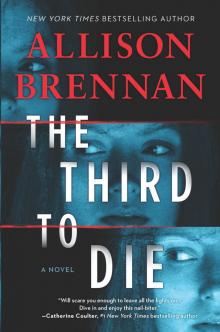 The Third to Die
The Third to Die Nothing to Hide
Nothing to Hide No Way Out
No Way Out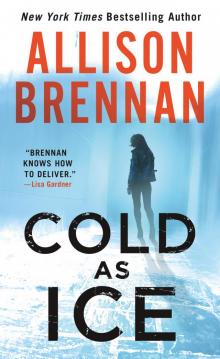 Cold as Ice
Cold as Ice Cut and Run
Cut and Run No Way Out (Lucy Kincaid Novels)
No Way Out (Lucy Kincaid Novels) Storm Warning
Storm Warning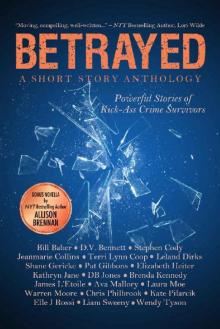 Betrayed: Powerful Stories of Kick-Ass Crime Survivors
Betrayed: Powerful Stories of Kick-Ass Crime Survivors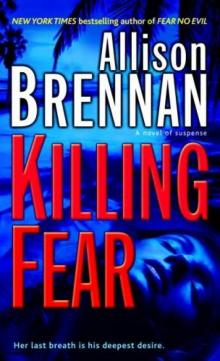 Killing Fear pb-1
Killing Fear pb-1 Make Them Pay
Make Them Pay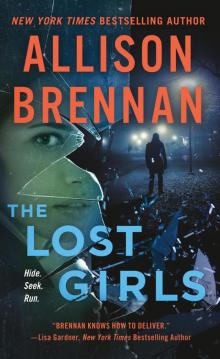 The Lost Girls
The Lost Girls Stalked
Stalked Killing Justice
Killing Justice A Deeper Fear
A Deeper Fear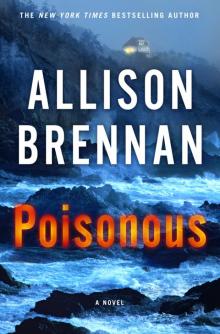 Poisonous
Poisonous Fear No Evil
Fear No Evil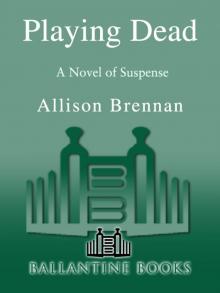 Playing Dead
Playing Dead Cold Snap
Cold Snap Vacation Interrupted
Vacation Interrupted Frosted (Moreno & Hart Mysteries)
Frosted (Moreno & Hart Mysteries)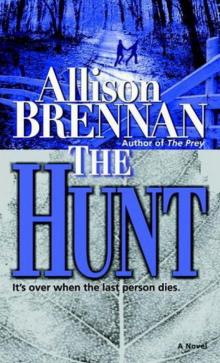 2 - The Hunt
2 - The Hunt Stolen
Stolen No Good Deed
No Good Deed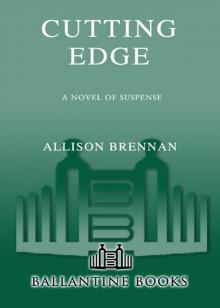 Cutting Edge
Cutting Edge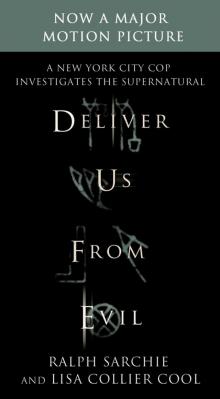 Deliver Us from Evil
Deliver Us from Evil If I Should Die
If I Should Die Speak No Evil
Speak No Evil Silenced lk-4
Silenced lk-4 Original Sin sds-1
Original Sin sds-1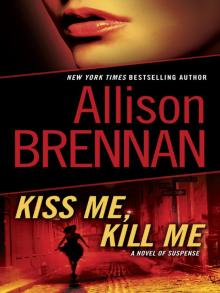 Kiss Me, Kill Me lk-2
Kiss Me, Kill Me lk-2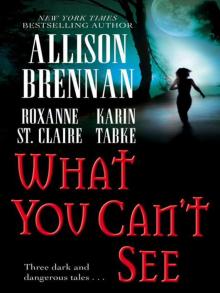 What You Can’t See
What You Can’t See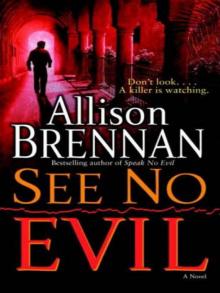 See No Evil
See No Evil The Prey
The Prey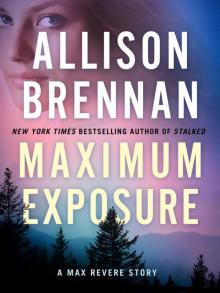 Maximum Exposure
Maximum Exposure Fatal Secrets f-2
Fatal Secrets f-2 Stalked lk-5
Stalked lk-5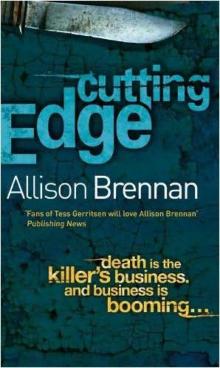 Cutting Edge f-3
Cutting Edge f-3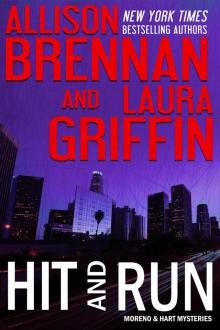 Hit and Run (Moreno & Hart Mysteries)
Hit and Run (Moreno & Hart Mysteries) Sudden Death f-1
Sudden Death f-1 If I Should Die lk-3
If I Should Die lk-3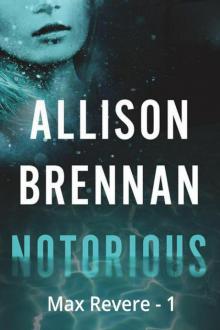 Notorious
Notorious Abandoned
Abandoned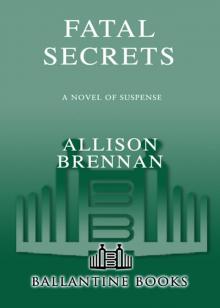 Fatal Secrets
Fatal Secrets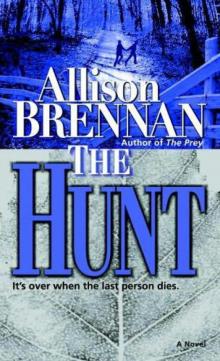 The Hunt
The Hunt Carnal Sin sds-2
Carnal Sin sds-2 Love Is Murder
Love Is Murder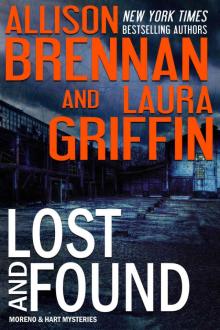 Lost and Found
Lost and Found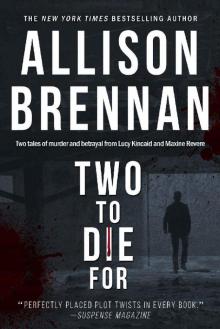 TWO TO DIE FOR
TWO TO DIE FOR Breaking Point
Breaking Point Best Laid Plans
Best Laid Plans Carnal Sin
Carnal Sin Silenced
Silenced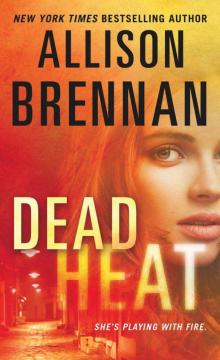 Dead Heat
Dead Heat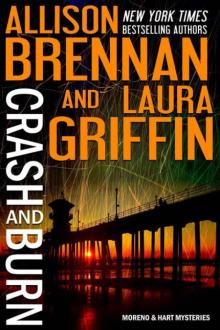 Crash and Burn
Crash and Burn Sudden Death
Sudden Death Lucy - 05 - Stalked
Lucy - 05 - Stalked Mortal Sin
Mortal Sin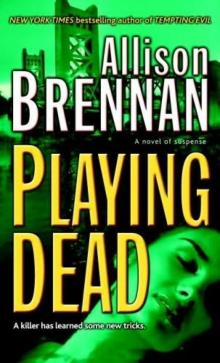 Playing Dead pb-3
Playing Dead pb-3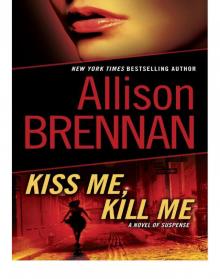 Kiss Me, Kill Me
Kiss Me, Kill Me Original Sin: The Seven Deadly Sins
Original Sin: The Seven Deadly Sins See No Evil e-2
See No Evil e-2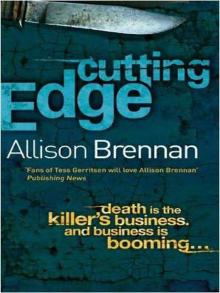 Cutting Edge: A Novel of Suspense
Cutting Edge: A Novel of Suspense Original Sin
Original Sin Too Far Gone
Too Far Gone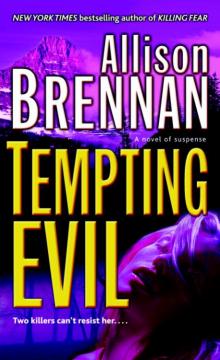 Tempting Evil
Tempting Evil Shattered
Shattered Killing Fear
Killing Fear Murder in the River City
Murder in the River City Love Is Murder (lucy kincaid)
Love Is Murder (lucy kincaid) Stolen (Lucy Kincaid Novels)
Stolen (Lucy Kincaid Novels)